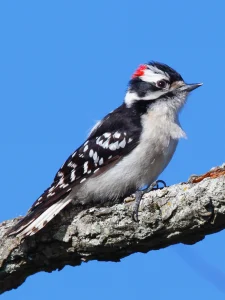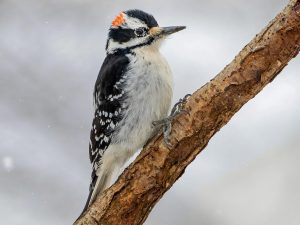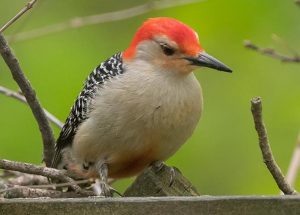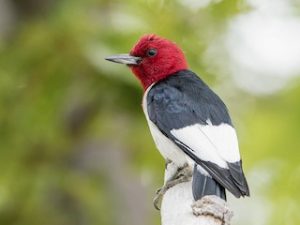There's no need to walk around your backyard looking for Minnesota woodpeckers because their drumming is unmistakable.
You know, what…
If your backyard has dead or decaying trees, you're probably housing resident woodpeckers. Your bird feeder can also encourage them to pass by in winter when there are no ants and beetles in forests, and suet sounds like a good option.
We'll make this article short and sweet by listing the Minnesota woodpecker species so you can prepare for your birding trip ASAP! Let's get started!
Types Of Woodpeckers in Minnesota: 9 Species That Call This State Home
1. Downy Woodpecker

It's among the smallest woodpeckers as it's smaller than a hairy woodpecker, and that's one way of telling the two species apart. Another differentiating feature is the bill, as a downy woodpecker has a shorter one.
If you identify birds by body size, a downy woodpecker is about 6.7 inches long and boasts a wingspan between 9.8 and 11.8 inches long. Also, a downy woodpecker has spotted outer tail feathers while a hairy woodpecker displays white ones.
A small red patch on the nape differentiates a male and female downy woodpecker. The rest of the body has the same black and white plumage as most woodpeckers.
Fortunately, this avian lives in Minnesota all year round, even in winter.
If you have a woodpecker bird feeder, serve suet and sunflower seeds to attract more downy woodpeckers. They also love insects, beetle larvae, berries, and acorns.
2. Hairy Woodpecker

We've mentioned that it's larger than downy woodpeckers because it grows between 7.1 and 10.2 inches long.
Luckily, the hairy woodpecker is also a resident species; therefore, you can compare it with the downy when you go birding. Winter is the best time to see a hairy woodpecker as that's when it eats more seeds to supplement the dwindling supply of insects.
Hairy woodpeckers hunt wood-boring insects. You'll hear them hammering tree barks with their chisel-like long bills or when they make the unique peek call, which is at a lower pitch than the sharp call of a downy.
A hairy woodpecker has black and white feathers and a red patch on the male.
3. Red-bellied Woodpecker

There are many ways to differentiate a red-bellied woodpecker from the two avians we've listed above.
For instance, its body length is longer than a downy because red-bellied woodpeckers are 9.4 inches long and 13 to 16 inches long from wing-to-wing. Its plumage is different from that of downy and hairy woodpeckers as the red-bellied woodpecker has a pale body and black bars on its back.
Red-bellied woodpeckers survive on insects like spiders, acorns, nuts, and seeds when they aren't coming for suet, peanut, and sunflower seeds in bird feeders. It drags insects out of crevices with the tip of its sticky and barbed tongue.
Unlike most birds, the red-bellied woodpeckers store winter food in tree cavities. If you encourage them to stay in your backyard, you'll wake up to fights between them and starlings, as red-bellied woodpeckers are aggressive and stab other birds with their bills.
Like the two Minnesota woodpeckers above, you can tell males from females by the red patch on their heads. Male red-bellied woodpeckers have a red patch that runs down the head from above the bill to the neck, while the one on females starts from the crown. Its call sounds like it's saying churr churr churr.
Red-bellied woodpeckers inhabit the eastern region of North America all year round, in forests and wooded suburbs.
4. Yellow-bellied Sapsucker

It also has black and white plumage like downy and hairy woodpeckers. A yellow-bellied sapsucker's throat distinguishes the male and female birds, with the male flaunting a red one while the female is white.
The yellow-bellied sapsucker is a migratory bird with a breeding range in the northern area of North America, and Minnesota is in this range.
Since tree sap is its main diet, the yellow-bellied sapsucker fancies forests with many trees, from maple to birch. You'll see it in deciduous forests in Minnesota, drilling a row of holes in living trees to create sap wells. This sap also traps insects as it flows and collects in the tree holes.
Other species take advantage of the hard work of these yellow-bellied sapsuckers and tap sap. For instance, you may see ruby-throated hummingbirds perched on top of the holes drinking sap.
The yellow-bellied sapsucker isn't a large bird as it grows to about 8.7 inches. You might come across some as tiny as 7 inches. Also, their bellies have pale yellow feathers that differentiate them from other woodpecker species.
5. Red-headed Woodpecker

This one also stores food in tree cavities like the species above.
A red-headed woodpecker is a stunning avian as its head is red, its back is black, and its belly is white. You can never confuse it with any species we've discussed so far.
Minnesota is in the bird's breeding range, though the southeastern area of this state has a resident population.
Other states around Minnesota, such as North and South Dakota, host birds during the breeding season, while the rest of the eastern states have resident red-headed woodpeckers. This avian is almost the size of a hairy woodpecker as its body length ranges between 7.5 and 9.1 inches.
Some of its favorite habitats are open woodlands with dead trees. Its population is declining because beech forests, where the red-headed woodpecker gets beechnuts, are decreasing fast.
To bring more red-headed woodpeckers into your backyard, leave dead trees for them to build nests. You'll know this species is on your property when you hear a tchur call that's higher-pitched than the sound of a red-bellied woodpecker.
6. Black-backed Woodpecker

It's about the size of a hairy woodpecker because its body length is 9.1 inches. Let's start with features that'll help you tell male and female black-backed woodpeckers apart. If you see a bird with a yellow patch on the head, it's male.
Fortunately, the black-backed woodpecker is easy to find in Minnesota, especially in forests burnt in the last few years.
These birds can locate such burnt forests just days after a forest fire to look for wood-boring beetles in the dead trees. They can live there for eight years if there's a generous supply of beetles.
There's a resident population in the northern area of North America. Fortunately, Minnesota has a resident population of the black-backed woodpecker on its northeastern edge. Listen for their distinct kyiik or pik calls when birding in coniferous forest.
7. Northern Flicker

Minnesota has a resident population of the northern flicker, while Canada and other northern areas host these birds during the breeding season. The yellow-shafted northern flicker inhabits the eastern region of North America. It has a red nape and yellow feathers on its tail and underwings, and the male yellow-shafted has a mustache.
The red-shafted northern flicker inhabits the western region, and both sexes have a red mustache. You see red-orange feathers on the tail and underwings as it flies.
Additionally, it has a gray face and a brown crown, unlike the brown face and gray crown of yellow-shafted northern flickers.
Northern flickers prefer the forest floor instead of tree trunks. They hammer soil foraging for ants and beetles, yet other woodpeckers drill trees. You're likely to see them near your feeder since they change their diet from ants and beetles to fruits and berries in winter. Listen for calls that sound like wicka wicka wicka.
8. Pileated Woodpecker

It's about twice the size of a downy woodpecker, as its body length is between 15.8 and 19.3 inches. You can't mistake this bird as it's as large as a crow, has white stripes on its face and neck, and a striking red crest. You can tell the male and female apart by the red stripe on the cheek of male pileated woodpeckers.
This species loves dead and fallen trees in mature forests, so you'll see a pileated woodpecker looking for rotten wood with ants, termites, and wood-boring beetles. A pileated woodpecker spends most of the day drumming trees, making up to 30 taps in a second. It almost sounds like a northern flicker as it makes a loud cuk-cuk-cuk-cuk sound.
To draw more pileated woodpeckers into your backyard, leave dead trees or stumps where carpenter ants can live.
Minnesota has a resident population of the pileated woodpecker, but only in the eastern region.
9. American Three-toed Woodpecker

We’ll list it here, even though it's only on the northeastern edge of Minnesota. The American three-toed woodpecker loves forests with beetle outbreaks after recent forest fires.
Having three toes is advantageous as an American three-toed woodpecker can lean away from the tree and increase the force it hits the tree, unlike other woodpeckers with four toes. Its breeding range is north, the farthest for any woodpecker except the Eurasian three-toed woodpecker.
Both sexes have barred backs and flanks and spotted wings. The males have a yellow patch on the crown. The American three-toed woodpecker is a small species but not as tiny as the downy as its body length ranges from 8.3 to 9.1 inches.
Birdhub Speak: Woodpeckers are all around the US, huh? Proceed here to see more of them -- Maine Woodpeckers.
Watch This!
Frequently Asked Questions
What is the most common woodpecker in Minnesota?
The downy woodpecker will show up on your binoculars lens more since it's the most common in North America. Install bird feeders, and downy woodpeckers will come to you as they're more likely to visit than other woodpecker species. They even feed on hummingbird feeders.
How many species of woodpeckers are in Minnesota?
This state has nine species. It's among the best places to spot woodpeckers in North America since some states have about five species only. The population of some species, such as the red-headed woodpecker, is decreasing due to issues like habitat loss.
Most woodpeckers in Minnesota are backyard visitors, and except for the migratory yellow-bellied sapsucker and the scarce American three-toed woodpecker, the others are easy to spot.
What is the largest woodpecker in Minnesota?
The pileated woodpecker is the largest in MN. It's about two times the size of the downy woodpecker.
Conclusion
Minnesota has nine woodpeckers, ranging from medium-sized woodpeckers like the red-bellied woodpecker to the largest in North America called the pileated woodpecker.
Fortunately, some come to backyard feeders, so you don't have to visit forests to see them. You may not offer beetle larvae like the wild boreal and mountain forests, but you can put suet and sunflower seeds.
Lastly, practice bird identification strategies so you'll have no trouble telling which avian is visiting your backyard bird feeders.
